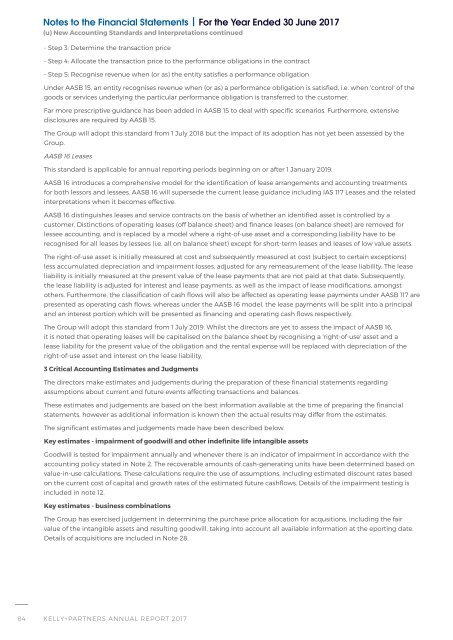070917_KPGHL_Annual Report 2017_final_PREVIEW
You also want an ePaper? Increase the reach of your titles
YUMPU automatically turns print PDFs into web optimized ePapers that Google loves.
Notes to the Financial Statements | For the Year Ended 30 June <strong>2017</strong><br />
(u) New Accounting Standards and Interpretations continued<br />
‐ Step 3: Determine the transaction price<br />
‐ Step 4: Allocate the transaction price to the performance obligations in the contract<br />
‐ Step 5: Recognise revenue when (or as) the entity satisfies a performance obligation<br />
Under AASB 15, an entity recognises revenue when (or as) a performance obligation is satisfied, i.e. when 'control' of the<br />
goods or services underlying the particular performance obligation is transferred to the customer.<br />
Far more prescriptive guidance has been added in AASB 15 to deal with specific scenarios. Furthermore, extensive<br />
disclosures are required by AASB 15.<br />
The Group will adopt this standard from 1 July 2018 but the impact of its adoption has not yet been assessed by the<br />
Group.<br />
AASB 16 Leases<br />
This standard is applicable for annual reporting periods beginning on or after 1 January 2019.<br />
AASB 16 introduces a comprehensive model for the identification of lease arrangements and accounting treatments<br />
for both lessors and lessees. AASB 16 will supersede the current lease guidance including IAS 117 Leases and the related<br />
interpretations when it becomes effective.<br />
AASB 16 distinguishes leases and service contracts on the basis of whether an identified asset is controlled by a<br />
customer. Distinctions of operating leases (off balance sheet) and finance leases (on balance sheet) are removed for<br />
lessee accounting, and is replaced by a model where a right‐of‐use asset and a corresponding liability have to be<br />
recognised for all leases by lessees (i.e. all on balance sheet) except for short‐term leases and leases of low value assets.<br />
The right‐of‐use asset is initially measured at cost and subsequently measured at cost (subject to certain exceptions)<br />
less accumulated depreciation and impairment losses, adjusted for any remeasurement of the lease liability. The lease<br />
liability is initially measured at the present value of the lease payments that are not paid at that date. Subsequently,<br />
the lease liability is adjusted for interest and lease payments, as well as the impact of lease modifications, amongst<br />
others. Furthermore, the classification of cash flows will also be affected as operating lease payments under AASB 117 are<br />
presented as operating cash flows; whereas under the AASB 16 model, the lease payments will be split into a principal<br />
and an interest portion which will be presented as financing and operating cash flows respectively.<br />
The Group will adopt this standard from 1 July 2019. Whilst the directors are yet to assess the impact of AASB 16,<br />
it is noted that operating leases will be capitalised on the balance sheet by recognising a 'right‐of‐use' asset and a<br />
lease liability for the present value of the obligation and the rental expense will be replaced with depreciation of the<br />
right‐of‐use asset and interest on the lease liability.<br />
3 Critical Accounting Estimates and Judgments<br />
The directors make estimates and judgements during the preparation of these financial statements regarding<br />
assumptions about current and future events affecting transactions and balances.<br />
These estimates and judgements are based on the best information available at the time of preparing the financial<br />
statements, however as additional information is known then the actual results may differ from the estimates.<br />
The significant estimates and judgements made have been described below.<br />
Key estimates ‐ impairment of goodwill and other indefinite life intangible assets<br />
Goodwill is tested for impairment annually and whenever there is an indicator of impairment in accordance with the<br />
accounting policy stated in Note 2. The recoverable amounts of cash‐generating units have been determined based on<br />
value‐in‐use calculations. These calculations require the use of assumptions, including estimated discount rates based<br />
on the current cost of capital and growth rates of the estimated future cashflows. Details of the impairment testing is<br />
included in note 12.<br />
Key estimates ‐ business combinations<br />
The Group has exercised judgement in determining the purchase price allocation for acqusitions, including the fair<br />
value of the intangible assets and resulting goodwill, taking into account all available information at the eporting date.<br />
Details of acquisitions are included in Note 28.<br />
84 KELLY+PARTNERS ANNUAL REPORT <strong>2017</strong>


